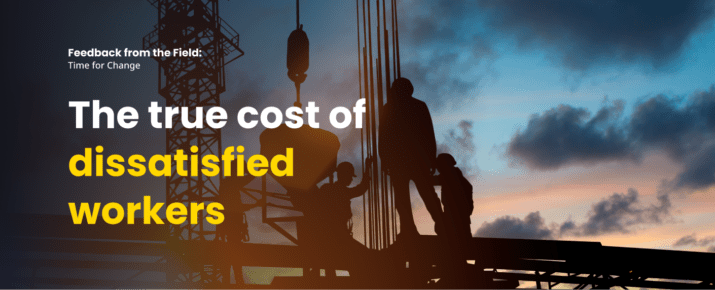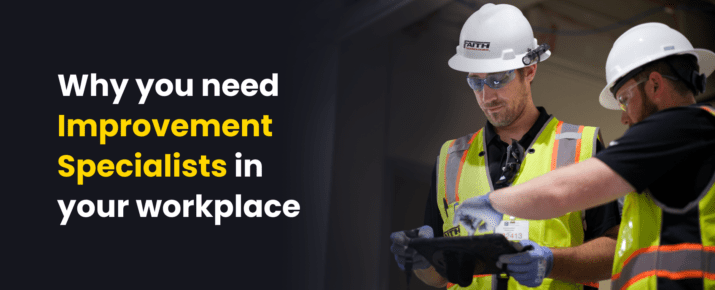Personal safety tips to keep lone workers safe
Ask The Experts | World Of Work | By | 23 Aug 2023 | 6 minute read

For a lot of people, working alone can be deeply rewarding. It caters to that need for independence and autonomy in your job. But there’s no denying it also comes with its own set of risks to your personal safety. Frontline lone workers often find themselves exposed to unique hazards in their solo work environments. So we’ve put together some tips to help ensure your personal safety while working away.
Types of lone workers
Specific jobs lend themselves to lone working for a significant amount of time. Whether it’s remote or isolated workers traveling and living solo for weeks or months at a time, or other professions like retail staff and security guards who may spend extensive periods alone, lone working can create unexpected risk factors.
Here are some of the most common jobs for lone workers:
Remote or isolated workers
These are workers whose place of work is such a long distance from home that they’re required to be away for an extended period. They often find themselves assigned to regional, remote, and isolated locations. Examples of long-distance workers include fly-in-fly out (FIFO), drive-in drive-out (DIDO), bus-in bus-out (BIBO), and ship-in ship-out (SISO). (For the sake of simplicity, we’ll refer to them as FIFO workers.)
This type of work is especially common in mining regions in Australia and Canada. Apart from miners, other examples of FIFO workers include laborers (carpenters, plumbers, electricians), hospitality workers (chefs, kitchen hands), drivers, machine operators, nurses, and cleaners.
Some challenges FIFO workers face include long working days, long-distance commuting from base to work site, fatigue, extreme weather conditions, and a lack of immediate assistance in emergencies. They’re not only open to risks while at work, but also to risks when commuting solo from home. For example, DIDO workers do long-distance drives alone for long distances through different terrain and occasionally in areas with poor cell reception.
Retail workers
After-hours retail employees are responsible for looking after the store during early and late hours when opening and closing up. They face potential security threats, especially in dimly lit areas or high-crime neighborhoods. They may also encounter aggressive customers or individuals affected by drugs and alcohol.
Hospitality workers
Many hospitality employees work late at night, from hotel receptionists to night staff to security guards. It’s not uncommon that they may run into unfamiliar guests or rowdy customers, and being in a lone-working environment can increase the risk of violence or harassment.
Healthcare workers
Home healthcare practitioners, social workers, and care workers frequently work alone – sometimes doing home visits for patients living in remote locations. This can lead to unpredictable situations, challenging working conditions, and potential exposure to infections.
It’s not only these occupations where workers might find themselves at risk. Danger and unexpected crises can strike from anywhere, so it’s important to recognize some of the top risk factors for lone workers.

Top risks factors for lone workers
Violence from customers or strangers
Lone workers in customer-facing roles are at an increased risk of enduring verbal abuse, physical threats, or outright physical violence from disgruntled customers. It’s essential to de-escalate any potential confrontation and seek immediate help when necessary. A recent example is the fatal stabbing of a young paramedic at a McDonald’s carpark in Sydney, Australia. The 29-year-old father was filling out paperwork in his ambulance during his early shift when he was attacked. This begs the question – what other measures could have been put in place to prevent something like this happening again in the future?
Working in dangerous environments
Lone workers in fields like construction and electrical contracting often face risky environments where effective job management is crucial. Utilizing electrician field service software can significantly optimize operations by improving scheduling, dispatching, and payments—allowing for better safety measures and overall efficiency. Protect your lone workers by adopting technology that caters specifically to remote work, like advanced field management solutions.
Adhering to safety protocols, wearing appropriate personal protective equipment (PPE), and receiving the proper training are essential in such environments. For example, electricians working in remote areas to construct high-voltage substations to power new towns and regions. In order to meet the safety requirements of this job, they would need to obtain a high-voltage and high-risk work license. Ensure you’re aware of the appropriate safety measures required and that your organization is providing this for you.
Driving long-distances
Truck drivers, traveling sales representatives, and other DIDO workers may frequently drive long distances, exposing themselves to road hazards, dangerous weather conditions, and fatigue-related risks. To make long-distance driving as safe as possible, take regular breaks, stay hydrated, get enough sleep, and avoid distractions while on the road.
Experiencing mental health challenges
Working alone for extended periods can lead to feelings of isolation, stress and anxiety, affecting lone workers’ mental wellbeing. It’s important to regularly stay in touch with colleagues, friends and family to get some much-needed support. If you’re experiencing persistent exhaustion, decreased motivation, or emotional detachment from your work, taking a burnout symptoms test can help you identify warning signs early and take proactive steps to protect your wellbeing.
“When you’re a lone worker, just being on your own is a hazard in itself,” says Luke Robinson, Risk Solutions Manager at SafetyCulture Care. “Psychosocial health in the workplace is so important, but especially for organizations with lone workers who are going out into the field. The onus is on businesses to say, ‘How can we best make sure our people are okay? How do we ensure these mental health hazards are identified and properly managed from a risk point?’”
“When you’re a lone worker, just being on your own is a hazard in itself.”
– Luke Robinson, Risk Solutions Manager at SafetyCulture Care.
7 personal safety tips for lone workers
The first step to safeguarding yourself against potential risks while working solo is to know some best-practice safety tips. Protect your lone workers by adopting technology that caters specifically to remote work, like advanced field management solutions or field service mobile applications. No matter what industry you work in or whether you do your job at home or out in the field, these tips could help you get out of a dangerous situation:
- Develop a comprehensive safety policy: Your employer should have already established and communicated a robust safety policy specifically designed for lone workers. This policy should include risk assessments, emergency procedures, training videos, guidelines for two-way communication, how to report incidents, and more.
- Check-in and communication: As a lone worker, you must establish regular check-in procedures with your supervisors, co-workers – and loved ones back home. Use communication devices, such as smartphones (keep an eye on phone reception), two-way radios, or lone worker safety apps like SHEQSY, which will help you maintain contact, and get a quick response in case of emergencies.
- Assess the work environment: Before you start work, lone workers should do a thorough assessment of their surroundings. Identify potential hazards and ensure all your safety equipment is in good working condition.
- Use personal safety devices: Invest in personal safety devices, such as duress alarms, to summon help quickly when faced with a dangerous situation. SafetyCulture allows you to do this with its lone worker tool SHEQSY, which can integrate with all your other tools like Microsoft Office, Power BI, Garmin, Google Calendar, and more.
- Self-defense training: Consider enrolling in a self-defense training course to add an extra layer to your personal safety, and build confidence around how to handle confrontational scenarios.
- Time management: Communicate with your manager if your current work schedule may lead to fatigue and burnout. Also, take regular breaks during long shifts to recharge.
- Record incidents: Keep a record of any safety incidents, near-misses, or suspicious activities that happen during work. No matter how small, it’s worth reporting them to HR or your dedicated safety department.
How SHEQSY is changing the game for lone workers
‘One of the best ways to protect yourself as a lone worker is with technology, particularly SHEQSY. This dedicated lone worker app protects you on the ground by shifting your mindset from a reactive worker to a proactive one. You’ll stay connected with other team members in real-time, while having peace of mind that you can always remain compliant with demanding health and safety regulations.
Beyond the inherent value of the app itself, SafetyCulture allows for further integration with other solutions like the ‘Remote and isolated work plan’ from SafetyDocs at SafetyCulture. The result is a more comprehensive and efficient approach to managing work safety.
“SHEQSY complements the ‘Remote and isolated work plan by providing real-time safety monitoring of remote workers,” says Craig Cruickshank, HSEQ Advisor and Project Manager at SafetyDocs. “As a cloud-based solution, SHEQSY allows for the seamless tracking of employee locations, job status, and wellbeing. Integrated with field service management software, it offers features such as GPS location tracking, emergency alerts, and two-way communication, ensuring managers have the tools to monitor and communicate with remote workers efficiently.”
Here are some of the key benefits of adopting a safety management solution like SHEQSY:
- Instant access to comprehensive safety protocols
- Real-time monitoring, with check-in confirmations and alert management
- Two-way comms so you can immediately report incidents and hazards
- Data analysis and reporting to improve your existing safety plans
- Greater accountability, regulatory compliance, and overall safety
Frontline lone workers are common across most industries, but despite the freedom this provides, they’re up against unique safety challenges. By understanding the risk factors and using some of these personal safety tips, lone workers can reduce the chances – and the impact – of dangerous situations.
Read more about lone working:
- What you need to know about lone working
- 5 key steps to improving lone worker safety
- Lone worker policy: A comprehensive guide
Important Notice
The information contained in this article is general in nature and you should consider whether the information is appropriate to your specific needs. Legal and other matters referred to in this article are based on our interpretation of laws existing at the time and should not be relied on in place of professional advice. We are not responsible for the content of any site owned by a third party that may be linked to this article. SafetyCulture disclaims all liability (except for any liability which by law cannot be excluded) for any error, inaccuracy, or omission from the information contained in this article, any site linked to this article, and any loss or damage suffered by any person directly or indirectly through relying on this information.





